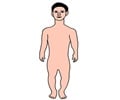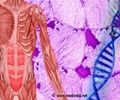
‘The fact that males contribute more genetic mutations than females is a feature of evolution observed not only across mammalian species but in diverse life forms, including birds and fish.’
Tweet it Now
Over time, the process of natural selection acts to retain those mutations that are beneficial to an organism's fitness -- its ability to grow to adulthood and successfully reproduce, while editing out mutations that cause declines in fitness. This perpetually self-correcting process allows for both the divergence of species into new and unpredictable forms and the ability of species to adapt to changing environments and optimize their chances of survival.
Melissa Wilson Sayres, an evolutionary geneticist affiliated with Arizona State University's Biodesign Institute, studies rates of mutation in a range of organisms, including humans. Much of her work focuses on the evolutionary contributions of a particular pair of chromosomes: the X and Y.
In a new study appearing in the journal Genome Biology and Evolution, Wilson Sayres and Pooja Narang examine a phenomenon known as male mutation bias.
"This project is driven by trying to understand why the mutation rate is different in genetic males vs. genetic females," Wilson Sayres says.
Advertisement
Each time a germline cell divides, its DNA must be faithfully duplicated in the resulting daughter cell. But the process is imprecise, and errors in the form of mutations can arise, like a word or phrase miscopied from a notebook.
Advertisement
Because sperm undergo many more cell divisions than eggs do, there is a greater likelihood of mutations derived from sperm entering the genome. This is exactly what has been observed across humans and other mammals.
Currently, there are over 100,000 disease-associated mutations in the Human Gene Mutation Database (HGMD). It is important for human health to determine the mechanisms underlying these mutations. From a therapeutic standpoint, replication-independent mutations, for example, those due to environmental factors, may be more susceptible to treatment.
Genes are those sections of the DNA that code for particular proteins and are responsible for most of our physical traits. Evolution is fussy about these areas of the genome because they are so vitally important to an organism's survival. Such sites are evolutionarily conserved, meaning that mutations that adversely affect fitness are edited out over successive generations.
Unsurprisingly, genetic mutations are therefore more common in the DNA regions falling between genes. Here, Nature may tamper with sequences in the genome, adding, subtracting or changing the fundamental units or nucleotides, without significant effects to an organism's health and well-being. "These regions in between the genes are compared in different species to understand how the species evolved," Narang says.
Until recently, DNA sites falling between coding genes were assumed to exhibit an equal vulnerability to mutation. Instead, new research shows that mutations increase as the distance from a given gene increases. In practical terms, this means that divergence between related species increases along the genome as one gets further from genes.
In comparing mutation rates in the X chromosomes vs. the autosomes, the new research goes a step further in overturning the paradigm of consistent mutation rates in non-coding regions. The data--derived from whole genome sequencing across the great apes, (including humans)--show that divergence increases with distance from genes in both the X chromosome and autosomes, but the divergence is more rapid on the X chromosome.
"The whole take-home of this study is that you have to be really careful about the genetic region you're looking at," Wilson Sayres says. "You have to get very far from genes in the genome to get a really accurate estimate of how many mutations are coming from genetic mom vs. genetic dad."
In the past, evolutionary geneticists have been hampered by the paucity of whole genome sequence data across the tree of life, but renewed efforts, driven by advances in technology, are rapidly changing the landscape. Comparative genomes from a wide range of species will soon come online, permitting fine-grained analyses of many biological features and their correlation with mutation rate.
Source-Eurekalert












